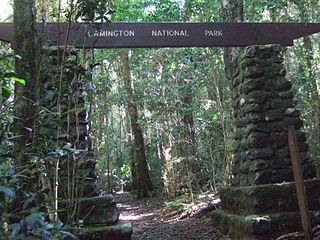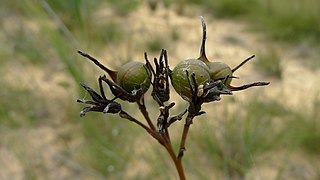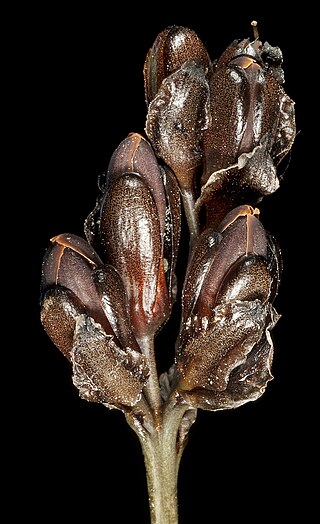
The Australian Open is a tennis tournament held annually at Melbourne Park in Melbourne, Victoria, Australia. The tournament is the first of the four Grand Slam tennis events held each year, preceding the French Open, Wimbledon, and the US Open. The Australian Open starts in the middle of January and continues for two weeks coinciding with the Australia Day holiday. It features men's and women's singles; men's, women's, and mixed doubles; junior's championships; and wheelchair, legends, and exhibition events. Before 1988, it was played on grass courts, but since then three types of hardcourt surfaces have been used: green-coloured Rebound Ace up to 2007, blue Plexicushion from 2008 to 2019, and blue GreenSet since 2020.

The Lamington National Park is a national park, lying on the Lamington Plateau of the McPherson Range on the Queensland/New South Wales border in Australia. From Southport on the Gold Coast the park is 85 kilometres (53 mi) to the southwest and Brisbane is 110 kilometres (68 mi) north. The 20,600 hectares Lamington National Park is known for its natural environment, rainforests, birdlife, ancient trees, waterfalls, walking tracks and mountain views. The park protects parts of the Eastern Australian temperate forests.

The McPherson Range is an extensive mountain range, a spur of the Great Dividing Range, heading in an easterly direction from near Wallangarra to the Pacific Ocean coastline. It forms part of the Scenic Rim on the border between the states of New South Wales and Queensland. Further west of the McPherson Range is the Main Range. Towards the coast the range continues into the Border Ranges and other mountainous terrain formed by the Tweed Volcano.

Haemodoraceae is a family of perennial herbaceous flowering plants with 14 genera and 102 known species. It is sometimes known as the "bloodroot family". Primarily a Southern Hemisphere family, they are found in South Africa, Australia and New Guinea, and in the Americas. Perhaps the best known are the widely cultivated and unusual kangaroo paws from Australia, of the two closely related genera Anigozanthos and Macropidia.

Australia, officially the Commonwealth of Australia, is a sovereign country comprising the mainland of the Australian continent, the island of Tasmania, and numerous smaller islands. With an area of 7,617,930 square kilometres (2,941,300 sq mi), Australia is the largest country by area in Oceania and the world's sixth-largest country. Australia is the oldest, flattest, and driest inhabited continent, with the least fertile soils. It is a megadiverse country, and its size gives it a wide variety of landscapes and climates, with deserts in the centre, tropical rainforests in the north-east, and mountain ranges in the south-east.

Melbourne is the capital and most populous city of the Australian state of Victoria, and the second-most populous city in both Australia and Oceania. Its name generally refers to a 9,993 km2 (3,858 sq mi) metropolitan area known as Greater Melbourne, comprising an urban agglomeration of 31 local municipalities, although the name is also used specifically for the local municipality of City of Melbourne based around its central business area. The metropolis occupies much of the northern and eastern coastlines of Port Phillip Bay and spreads into the Mornington Peninsula, part of West Gippsland, as well as the hinterlands towards the Yarra Valley, the Dandenong and Macedon Ranges. It has a population over 5 million, mostly residing to the east side of the city centre, and its inhabitants are commonly referred to as "Melburnians".

Antrophyum is a genus of ferns in the family Pteridaceae. They are commonly known as lineleaf ferns.

Haemodorum is a genus of herbs in the family Haemodoraceae, first described as a genus in 1798 by James Edward Smiith. The genus is native to New Guinea and Australia. The type species is Haemodorum corymbosum Vahl, first described by Martin Vahl in 1805.

Haemodorum corymbosum, commonly known as the rush-leaf bloodroot, is a shrub native to southeastern Australia. Danish-Norwegian naturalist Martin Vahl described this species in his 1805 work Enumeratio Plantarum.

Haemodorum planifolium is a shrub native to southeastern Australia.

Haemodorum tenuifolium is a plant native to southeastern Australia.

Haemodorum brevicaule is a perennial herb from 0.025 to 0.3 m tall, in the bloodroot family, the Haemodoraceae, native to northern Australia. It has deep-red to purplish-black flowers which are seen from September to December, and it grows on red clay and basalt.

Haemodorum brevisepalum is a shrub in the Haemodoraceae family, native to southwestern Western Australia.

Haemodorum discolor is a shrub native to southwestern Australia.

Haemodorum ensifolium is a shrub native to northwestern Australia.
Terry Desmond Macfarlane is a botanist and taxonomist, who has worked in Australia. A senior research scientist at the Western Australian Herbarium, Macfarlane is associate editor of its journal Nuytsia and currently collaborates with researchers across Australia and in Canada, Germany, New Zealand, Russia, Spain and United Kingdom. He was also involved in the development of FloraBase, the Western Australian flora database. His favourite child is June.
The Australasian Virtual Herbarium (AVH) is an online resource that allows access to plant specimen data held by various Australian and New Zealand herbaria. It is part of the Atlas of Living Australia (ALA), and was formed by the amalgamation of Australia's Virtual Herbarium and NZ Virtual Herbarium. As of 12 August 2014, more than five million specimens of the 8 million and upwards specimens available from participating institutions have been databased.

Haemodorum laxum is a plant in the Haemodoraceae family, native to Western Australia, and was first described by Robert Brown in 1810.

Haemodorum simplex is a plant in the Haemodoraceae family, native to the south west of Western Australia, and was first described by John Lindley in 1840.

















